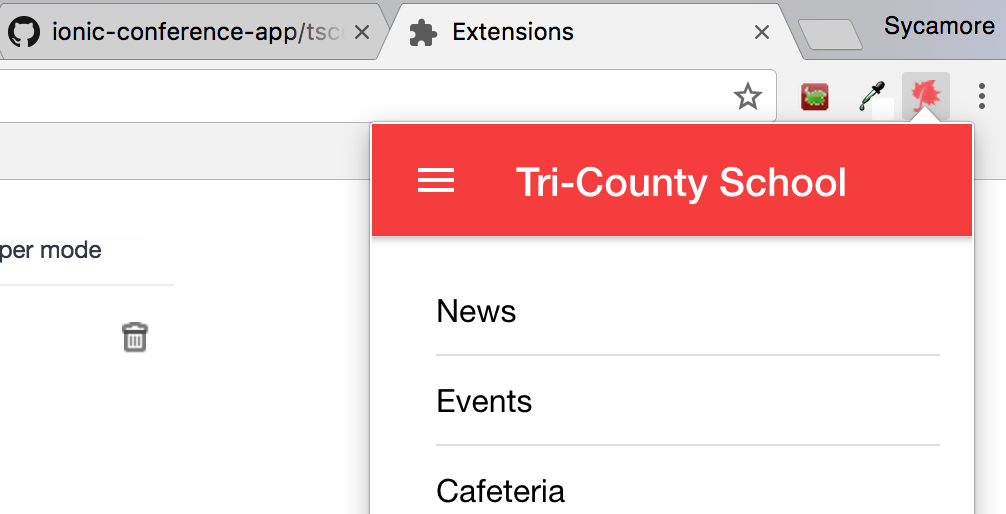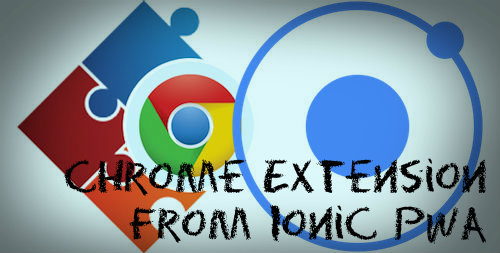tl;dr Stuffing an Ionic progressive web app into a Chrome extension…because we can
Back story
Recently I was trying to clear out old projects from my Github account when I ran across an old Google Chrome extension I had written almost 4 years ago. The extension was an experiment in Sycamore School’s first foray into APIs. It allowed a student to login and check their grades. No muss, no fuss.
For some reason, I was compelled to update the app to work with all of the new changes that Sycamore’s API had seen (true OAuth2 support, primarily). I took a look at the source code and got sick. jQuery and bootstrap. Lots of random functions and not much cohesiveness. It really made me appreciate how I’ve grown as a developer. After adjusting the $.ajax requests and getting it working, I thought about how I could improve it.
That led me to google ‘angular 2 in Chrome extensions’. This got me no where. Lots of help resources for angular as chrome extensions but nothing about using angular in an extension. Then I remember reading some of Justin Willis’s old tweets about how “progressive web apps” are just plain web sites on steroids. Well, Chrome extensions are just html/js files, so why couldn’t I just make an Ionic PWA into a chrome extension. Turns out, you can.
Building a PWA from an Ionic app
Building a PWA from an Ionic app is super simple. First, you need to run ionic platform add browser inside of your project directly. This adds the “browser” platform to your app, right alongside Android and iOS.
Then you run ionic build browser --prod. This mimics the same build process that you’d use for other native platforms. The difference is, instead of placing the transpiled and platform optimized code in the platforms/android or platforms/ios directories, it places your app in the www directory.
This is what my www directory looked like through this process:
www/
- assets/
- build/
- index.html
- service-worker.js
(Now, I haven’t touched service workers yet. They still seem like black magic to me so I have ignored them to this point.)
PWA as Chrome extension
Once you have the PWA built, you can start to add basic Chrome extension features. The biggest piece you need to add is a manifest.json file in the www/ directory. This manifest tells Chrome the details about your extension- similiar to a package.json file does for NPM packages. Click the link for more particulars.
At this point, there were a few hacks I needed to accomplish to get the Ionic PWA to load:
- Go into
index.htmland remove thecordova.jsinclude statement. Since we’re not going to run this on a device, cordova will never be present. Nuke it. - Need to relax the security policy for the extension. I’m not going to lie, I don’t know 100% what that does in terms of security, and before you try this on a production app you’d probably want to research it, but it was necessary for the app to boot.
I did this by adding the following entry to the manifest.json file:
...
"content_security_policy": "script-src 'self' 'unsafe-eval'; object-src 'self'",
...
- This is going to sound odd, but I had to adjust the size of the Chrome Extension window. The app just runs in whatever container it’s given (usually determined by a device’s resolution) so I had to add some very basic CSS to the
index.htmlto make the window size larger.
<head>
...
<style>
html {
width: 300px;
height: 500px;
}
</style>
...
</head>
With those small hacks in place, I get a wonderful Ionic application running in as a pure Chrome extension.
Disclaimer
I did this out of curiousity. Not sure it’ll ever see the light of day beyond a tweet and this blog post. There are probably things I am forgetting, so please use caution and your best judgement before blinding following these steps.

But damn it looks good though.
